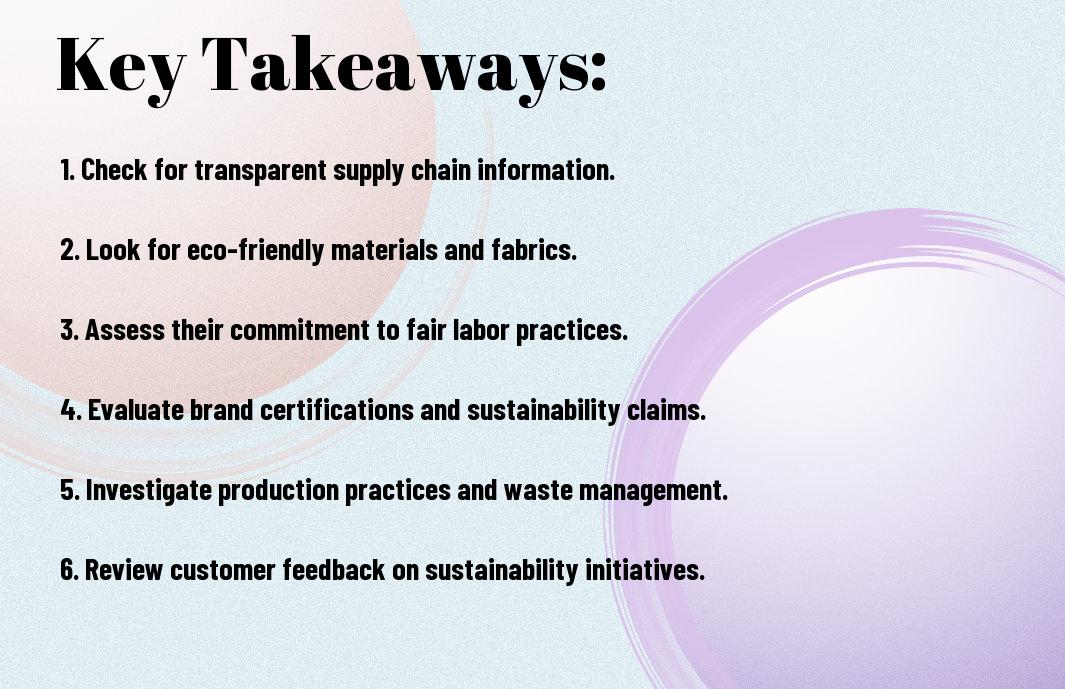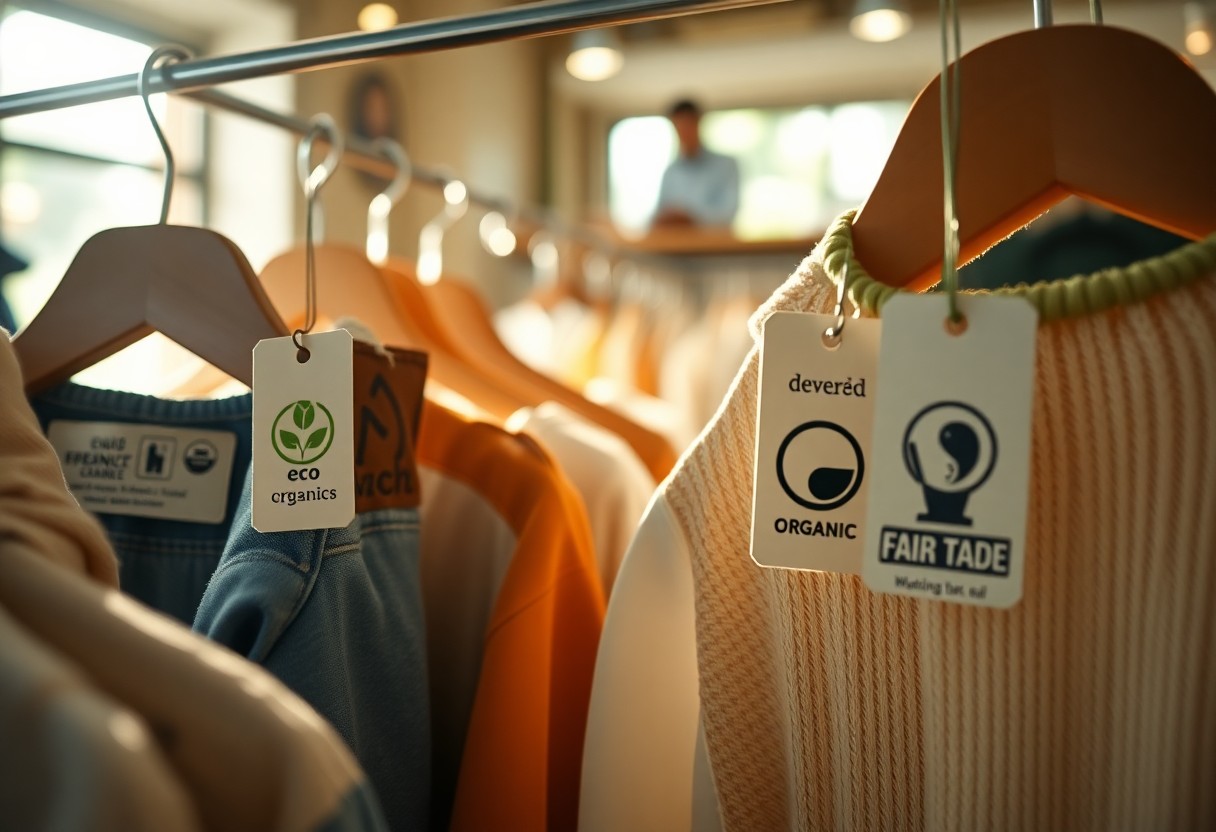As you navigate the vast expanse of the fashion world, you may find yourself bewildered by the plethora of brands claiming to be sustainable. But, dear reader, do not be swayed by empty promises. Your discerning eye must be trained to distinguish between genuine eco-friendly endeavours and mere marketing ploys. In this guide, you will discover the telltale signs of truly sustainable fashion brands, allowing you to make informed choices that align with your values and contribute to a more refined, responsible approach to style.
Key Takeaways:
To identify genuine sustainable fashion brands, consider the following points:
- Look for brands that prioritize transparency, providing clear information about their supply chain, manufacturing processes, and environmental policies.
- Check if the brand has obtained certifications such as GOTS, Oeko-Tex, or Bluesign, which ensure compliance with environmental and social standards.
- Assess the brand’s material sourcing, opting for those that use recycled, organic, or regenerated materials, and avoid those that contribute to deforestation or pollution.
- Investigate the brand’s labor practices, ensuring that they promote fair wages, safe working conditions, and equal opportunities for all employees.
- Evaluate the brand’s end-of-life policies, such as garment recycling programs or take-back initiatives, which encourage circularity and reduce waste.
Key Principles
Before delving into the world of sustainable fashion, you must understand the fundamental principles that guide your purchasing decisions, ensuring your choices align with your values and promote a more environmentally-friendly industry.
Environmental Impact
Along with the growing awareness of climate change, you are likely to encounter brands that prioritize reducing waste, using recycled materials, and implementing practices that minimize harm to the environment, allowing you to make informed choices that support your eco-conscious lifestyle.
Social Responsibility
Before committing to a brand, you should investigate their stance on social responsibility, considering factors such as fair labor practices, safe working conditions, and community involvement, which can significantly influence your perception of the brand’s overall sustainability.
Environmental concerns often intersect with social responsibility, as you will find that brands prioritizing fair labor practices also tend to adopt more eco-friendly production methods, demonstrating a comprehensive approach to sustainability that considers both the well-being of people and the planet, enabling you to make thoughtful decisions that align with your values.

Transparency
One of thekey indicators of a sustainable fashion brand is its willingness to be open about its practices. You should look for brands that provide detailed information about their production processes, allowing you to make informed decisions about your purchases.
Supply Chain Disclosure
On the subject of transparency, you will want to investigate whether a brand discloses its supply chain. You can often find this information on the brand’s website, where they may publish a list of their suppliers and manufacturers, giving you insight into their business practices.
Materials Sourcing
About the materials used in your clothing, you may wonder where they come from. You should consider brands that clearly state the origin of their materials, as this can impact the environment and the people involved in the production process.
A closer look at materials sourcing will also help you understand the brand’s commitment to sustainability. As you research deeper, you will find that some brands prioritize environmentally-friendly materials, such as organic cotton or recycled fabrics, while others may overlook the environmental impact of their sourcing practices, allowing you to make a more informed decision about the brands you support.

Certifications
Not all fashion brands are created equal, and certifications can help you distinguish between those that are truly sustainable and those that are merely pretending to be. As you navigate the complex world of sustainable fashion, you will encounter various certifications that attest to a brand’s commitment to environmental and social responsibility.
Eco-Labels
Alongside other markers of sustainability, an array of eco-labels can provide you with valuable insights into a brand’s eco-friendly practices. You will find that labels such as GOTS or Oeko-Tex guarantee that the brand’s products meet rigorous environmental standards.
Fair Trade Certifications
Following your investigation into eco-labels, after verifying a brand’s commitment to environmental sustainability, you should also look for fair trade certifications. You can trust that brands bearing fair trade certifications prioritize the well-being of their workers and engage in ethical business practices.
Plus, as you probe deeper into the world of fair trade certifications, you will discover that they not only ensure fair wages and safe working conditions but also promote sustainable livelihoods and community development, allowing you to make a positive impact with your fashion choices, and contributing to a more equitable fashion industry, one that values both people and the planet, and you will find that your purchases are not only a reflection of your personal style but also a testament to your values and commitment to creating a better world.
Red Flags
For your own discernment, it is crucial to be aware of the pitfalls that can lead you astray in your pursuit of sustainable fashion. You must be vigilant in your research, lest you fall prey to deceptive tactics.
Greenwashing
Across the vast expanse of the fashion industry, you will encounter numerous brands that claim to be sustainable, but in reality, are merely employing clever marketing ploys to deceive you. You should be cautious of such tactics, which can be detrimental to your noble pursuit of environmentally friendly fashion.
Lack of Accountability
About the time you start to scrutinize a brand’s sustainability claims, you will likely come across vague statements and a lack of concrete evidence to support their assertions. You may find yourself wondering if they are truly committed to sustainability or simply paying lip service to the concept.
At the heart of the matter, a lack of accountability can be a significant obstacle in your quest for sustainable fashion. You see, when a brand fails to provide transparency in their practices and supply chain, it becomes increasingly difficult for you to make informed decisions about the clothing you purchase, and you may inadvertently contribute to the very problems you seek to avoid, thus undermining your own values and principles.
Research Methods
Your quest for sustainable fashion begins with thorough research, and a helpful tool is Good On You – Sustainable Fashion and Beauty Brand Ratings, which provides valuable insights into a brand’s commitment to sustainability.
Online Reviews
Ordinarily, online reviews from multiple sources can provide a well-rounded view of a brand’s sustainability efforts, allowing you to make informed decisions about the brands you support.
Brand Reports
Approximately, brand reports can offer a detailed look into a company’s practices, giving you a clearer understanding of their values and mission.
Reviews of brand reports often highlight the strengths and weaknesses of a company’s sustainability initiatives, enabling you to assess whether their values align with your own, and make purchasing decisions that reflect your commitment to sustainable fashion.
Making Informed Choices
Once again, you find yourself at the forefront of a most noble pursuit: navigating the complexities of sustainable fashion. As you launch on this journey, you will discover that making informed choices is the cornerstone of a more conscientious approach to style.
Reading Labels
With a discerning eye, you will begin to scrutinize the labels on your garments, searching for telltale signs of eco-friendly practices and responsible sourcing. Your attention to detail will serve you well in this endeavor.
Asking Questions
Above all, you must be willing to inquire about the practices and policies of your favorite brands, for it is through such diligence that you will uncover the truth about their commitment to sustainability.
Asking questions is an vital part of your journey towards a more sustainable wardrobe. You will want to inquire about the materials used, the manufacturing processes, and the treatment of workers involved in the production of your clothing. By doing so, you will be able to make more informed decisions about the brands you choose to support, and ultimately, cultivate a more thoughtful approach to your fashion choices.
Final Words
On the whole, you will find that discerning truly sustainable fashion brands requires a keen eye for detail and a commitment to your values. As you navigate the complex world of fashion, you will be well served by your newfound knowledge, enabling you to make informed choices that align with your conscience and your sense of style. Your thoughtful approach will ultimately contribute to a more equitable and environmentally mindful industry, and for that, you should be justly proud.
FAQ
Q: What are some key indicators of a truly sustainable fashion brand?
A: When looking for a sustainable fashion brand, there are several indicators to look out for. First, check if the brand uses environmentally-friendly materials, such as organic cotton, recycled polyester, or Tencel. Additionally, look for brands that prioritize reducing waste, using techniques such as upcycling or zero-waste design. Transparency is also key, so look for brands that openly share information about their supply chain, manufacturing processes, and environmental impact. Finally, consider brands that adopt a slow fashion approach, encouraging customers to buy fewer, higher-quality items that will last longer.
Q: How can I verify the sustainability claims made by a fashion brand?
A: Verifying sustainability claims can be challenging, but there are several steps you can take. First, look for third-party certifications such as GOTS (Global Organic Textile Standard), Bluesign, or Oeko-Tex, which indicate that the brand meets certain environmental and social standards. You can also check the brand’s website for detailed information about their sustainability practices, such as their environmental policies, supply chain management, and worker welfare initiatives. Another approach is to check independent reviews and ratings from organizations such as the Fashion Transparency Index or the Good On You app, which evaluate fashion brands based on their sustainability and ethical performance.
Q: What role do I, as a consumer, play in promoting sustainable fashion, and how can I make a positive impact?
A: As a consumer, you play a significant role in promoting sustainable fashion by making informed purchasing decisions. Start by buying second-hand or renting clothing, which reduces the demand for new, resource-intensive garments. When buying new, choose brands that prioritize sustainability, and consider the lifespan of the garment – will it be worn frequently, or is it likely to end up in a landfill after a few uses? You can also care for your clothes in a way that extends their lifespan, such as washing them in cold water, avoiding fabric softener, and repairing them when they become damaged. Finally, support brands that adopt circular business models, such as clothing take-back programs or garment recycling initiatives, which help to reduce waste and promote a more circular fashion industry.
